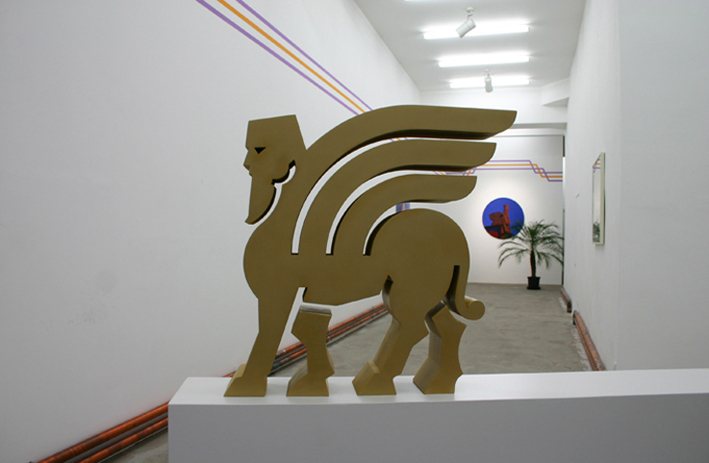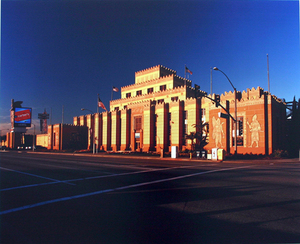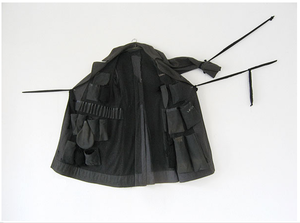This is an archive of the ArtCat Zine, 2007-2009. Please visit our new project, IDIOM.
Historic Fiction

City of Commerce
Sophie-Therese Trenka-Dalton’s
Nice & Fit - Brunnenstrasse 13, Berlin DE
3 April - 24 May 2008
Heiligsprechung
Jana Gunstheimer’s
filiale - Brunnenstrasse 188-190, Berlin DE
4 April - 24 May 2008
Running concurrently, directly across the street from each other in Berlin, are exhibitions by Sophie-Therese Trenka-Dalton and Jana Gunstheimer.
Gunstheimer’s Heiligsprechung (Canonization) covers a period of time starting in 1977 when citizens in Austria could apply for sainthood. The exhibition is filled with the documents and artifacts of the applicants, and the eventual exposure of the government’s offer as a sham designed to generate revenues from application fees.
Trenka-Dalton likewise digs into history for her exhibition City of Commerce, which examines Assyrian culture in a manner that is now almost the only way left to experience it: through its material representations and reconstructions in museums, reproductions on postcards, or its influence on contemporary architecture. Some of her artifacts are gathered from actual field trips: not to Iraq, but rather to sites like the Louvre, the British Museum, and The Citadel, an outlet mall in a suburb of Los Angeles housed in what used to be a tire factory modeled on the Palace of King Sargon II.
The exhibitions have much in common. Both women are excellent crafts-persons and both have chosen the language of museums — the vaults of history — to speak on the unreliability of these stories.
In the case of Heiligsprechung, the feeling of the exhibition is similar to having entered a shrine dedicated to a singular event. The model of the arch, that was to be constructed over the street where the saints would be paraded, feels cheap. It is wonderfully constructed, but from materials that betray the museum’s limited budget. The framed application forms of the people eager to be recognized for their goodness are yellowed with time, and it is easy to imagine an elderly volunteer sitting in a tobacco-stained ticket booth at the entrance to these collected stories. And what stories they are! Take for example a group of criminals determined to reform themselves for the good; as a symbol of their intentions, the group had their wrists tattooed declaring their resolve: to be kind, to protect you, to shield your life from the sort of persons they used to be. But how sincere are they? The cover letter they turn in with their sainthood application form is rather dodgy, and we begin to suspect that these men are not as reformed as they'd like us to believe.
Then again they never really existed in the first place; the narrative here is a pure work of fiction composed by the artist, like the rest of the stories in Heiligsprechung. The photographs and newspaper clippings are watercolors; Gunstheimer likewise has authored the false application forms and other artifacts. And as if it weren’t enough to create an entire fictional museum, with all the necessary bureaucratic scaffolding, there is also a newspaper available, Massnahme, which works as a catalogue for the exhibition. It is a false reportage on a fictional history, which makes it in some ways as real a newspaper as any. Though newspapers are relied on to gather the truths of our day, we are all well aware that newsprint can be filled with inky lies. Likewise we know that the authority of museum aesthetics (the authority in fact of any aesthetic) stands on paper-thin legs, and should never be trusted blindly. Yet in telling such tall tales, Gunstheimer highlights the one simple truth that inspired the work in Heiligsprechung: that the church and the state were in tight union as they together explored joint profit producing ventures. In other words, all of this could have happened, and the most surprising thing for visitors is learning that it did not.

Trenka-Dalton’s exhibition doesn’t coat the work with fiction in the same way. She doesn’t have to. The subjects that she brings forward are already so clouded with retellings and artifice she simply reconstructs them one more time, like adding one more layer of varnish over a forgery. It is more how she then assembles the various artifacts with no lines of separation. One of the works is a scale model of an arch that one can walk under at the Louvre. In City of Commerce we tower above the arch, which is here in a display case for artifacts collected by the artist: a souvenir Lucite paperweight commemorating the California gold rush, photos taken in the Louvre, money from Iraq which has on its backside an etching of the palace the tire factory is based on, and a gambling chip from the casino across the street from the tire factory (just as the factory borrowed an Assyrian aesthetic from the Palace of King Sargon II, the casino borrowed an aesthetic from the factory, in an architectural version of the telephone game). To combine all these elements seems natural when the idea of authenticity is obsolete. As the artist herself says, “Monumentality is (the) reappearing motif in this project.”
In Heiligsprechung, the would-be saints allowed their lives to be investigated, and many were found guilty of small to large-scale crimes. This was more a side effect than the intention of the program, though the conclusion (in Gunstheimer’s political fairy tale) carries the stink of religious persecution, cleverly scripted as a comedy of errors.
Across the street the major fiction is one common to old-school museums, where the focus is on historical artifacts: the fiction of omission. Politics are often sidestepped or thrown in as small footnotes, and the more contemporary the politic, the more “out of place” it is in historical museums. But of course these are not “real” museums; these are contemporary art galleries, and in making work that addresses the presentation of history, both projects cast our sights towards the blur between historical fiction and history fictionalized. Trenka-Dalton especially seems to be concerned with this “negative space” — the parts of history and contemporary politics left unaddressed, for example, in a Post-Saddam Iraq.
Certainly what stands out in both artists' work is how the digging into history sifts out the small nuggets of truth, and we see our pasts, even once uncovered, potentially buried again under aesthetics and authority.
ZINE
HOME
TIPS / COMMENTS
CATEGORIES
CONTRIBUTORS
- Greg Afinogenov
- B. Blagojevic
- Adda Birnir
- Susannah Edelbaum
- Julie Fishkin
- Paddy Johnson
- Jessica Loudis
- Christopher Reiger
- Andrew Robinson
- Peter J. Russo
- Blythe Sheldon
- S.C.Squibb
- Hrag Vartanian

